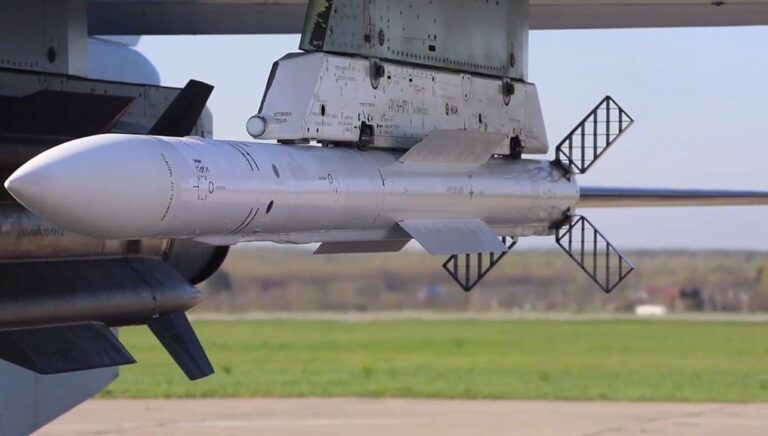Recent reports and battlefield observations suggest that Russian forces have begun deploying the latest variant of their R-77 air-to-air missile, the R-77M, in the ongoing conflict in Ukraine. The introduction of this advanced weapon system marks a significant development in aerial combat capabilities on the Eastern European front, potentially altering the dynamics of air engagements. This article examines the emerging evidence of the R-77M’s operational use, analyzing imagery, intercepted communications, and expert assessments to understand its impact and strategic implications within the broader conflict.
Emerging Evidence of R-77M Deployment in Ukraine Airspace
Recent battlefield reports and visual confirmations have begun to surface, indicating that Russian forces may be operationally deploying the advanced R-77M air-to-air missile within Ukraine’s contested airspace. This latest iteration of the Vympel missile boasts upgraded targeting systems and extended range capabilities compared to its predecessors, potentially altering the aerial engagement dynamics over the region. Multiple eyewitness accounts from Ukrainian pilots have described engagements consistent with the R-77M’s signature flight profile and improved agility, corroborated by intercepted telemetry and radar tracking data analyzed by independent defense experts.
Key features reported to distinguish this missile in active combat scenarios include:
- Enhanced seeker head technology enabling better resistance to electronic countermeasures.
- Extended range of up to 110km, surpassing older medium-range air-to-air weapons in theater.
- Advanced thrust vectoring controls contributing to superior maneuverability during dogfights.
| Capability | R-77 (Base Model) | R-77M (New Variant) |
|---|---|---|
| Maximum Range | 80 km | 110 km |
| Seeker Type | Infrared & Semi-Active Radar | Active Radar with ECCM |
| Maneuverability | High | Very High (Thrust Vectoring) |
Technical Features and Combat Advantages of the New Russian Missile
The latest generation R-77M air-to-air missile, reportedly spotted in Ukrainian skies, integrates cutting-edge technology that magnifies its lethality and tactical impact. Enhanced with a new active electronically scanned array (AESA) seeker, the missile boasts improved target acquisition and resistance to jamming systems, allowing for precise engagements even in complex electronic warfare environments. This upgrade translates to a higher kill probability against both fast and maneuverable targets. Complementing this is its extended range capability, which rivals that of Western counterparts, enabling Russian pilots to strike effectively beyond visual range, thus altering the dynamics of air combat in the region.
Key combat advantages of the R-77M stem from a combination of advanced guidance, propulsion, and maneuverability enhancements:
- Improved AESA Seeker: Enables superior target tracking and resilience against countermeasures.
- Solid-Fuel Ducted Ramjet Engine: Provides sustained thrust for longer flight and greater speed, complicating enemy evasive actions.
- Enhanced Aerodynamics: Facilitates sharp maneuvers at high G-forces, increasing hit probability on agile fighters.
- Networked Targeting: Capable of mid-course updates via datalink, allowing dynamic retargeting and cooperative engagements.
| Feature | Specification | Combat Benefit |
|---|---|---|
| Range | ~110 km | Engage targets beyond visual range |
| Seeker Type | Active AESA radar | Improved jamming resistance |
| Feature | Specification | Combat Benefit |
|---|---|---|
| Range | ~110 km | Engage targets beyond visual range |
| Seeker Type | Active AESA radar | Improved jamming resistance |
| Propulsion | Solid-fuel ducted ramjet engine | Sustained thrust for longer flight and higher speed |
| Maneuverability | Enhanced aerodynamics allowing high-G maneuvers | Increased hit probability against agile targets |
| Guidance | Networked targeting with mid-course data-link updates | Dynamic retargeting and cooperative engagement |
If you want me to help with anything else related to the R-77M missile or provide further analysis or formatting, please let me know!
Implications for NATO Surveillance and Recommendations for Tactical Response
The emergence of the R-77M missile in the Ukrainian theater signals a significant shift in the aerial threat matrix confronting NATO forces. Enhanced radar homing capabilities and extended engagement ranges of this weapon demand a recalibration of existing surveillance protocols. NATO’s airborne early warning and control assets must increase their operational readiness to detect lower-observable, faster targets at varying altitudes and ranges. In particular, improving signal intelligence (SIGINT) and electronic support measures (ESM) will be critical to intercept and analyze missile launch signatures promptly, enabling faster decision cycles for allied pilots and command centers.
For ground-based air defense units, an adaptive, layered response strategy is recommended. This should include:
- Upgrading radar systems to handle the R-77M’s improved electronic counter-countermeasures (ECCM).
- Integrating multi-domain sensor networks that combine aerial, satellite, and ground-based inputs for comprehensive tracking.
- Enhancing pilot training on missile evasion tactics specific to the R-77M’s flight profile and maneuverability.
Cooperation and intelligence-sharing among NATO members will also be paramount in creating a real-time fused operational picture, mitigating the impact of this advanced missile system.
| Aspect | NATO Tactical Adjustment | Expected Benefit |
|---|---|---|
| Surveillance Range | Extend radar detection by 30% | Early warning of missile launches |
| Electronic Warfare | Enhance ECCM capabilities | Maintain missile tracking fidelity |
| Pilot Training | Introduce R-77M evasion drills | Increase pilot survivability |
Final Thoughts
As the conflict in Ukraine continues to evolve, the emergence of Russia’s new R-77M air-to-air missile marks a significant development in the contested airspace. Indicators of its deployment underscore Moscow’s intent to enhance its aerial combat capabilities amid sustained hostilities. Monitoring the use and impact of the R-77M will be crucial in assessing shifts in air superiority and the broader tactical dynamics playing out in the region. Analysts and military observers will no doubt continue to watch closely for further evidence of this missile’s role in the ongoing conflict.
. . .




